St Andrews
About Andrew Cusack
 Writer, web designer, etc.; born in New York; educated in Argentina, Scotland, and South Africa; now based in London.
Writer, web designer, etc.; born in New York; educated in Argentina, Scotland, and South Africa; now based in London. read more
News
Blogs
Reviews & Periodicals
Arts & Design
World
France
Mitteleuropa
Knickerbockers
Argentina
The Levant
Africa
Cape of Good Hope
Netherlands
Scandinavia
Québec
India
Muscovy
Germany
Academica
St Margaret Relic Heads to St Andrews
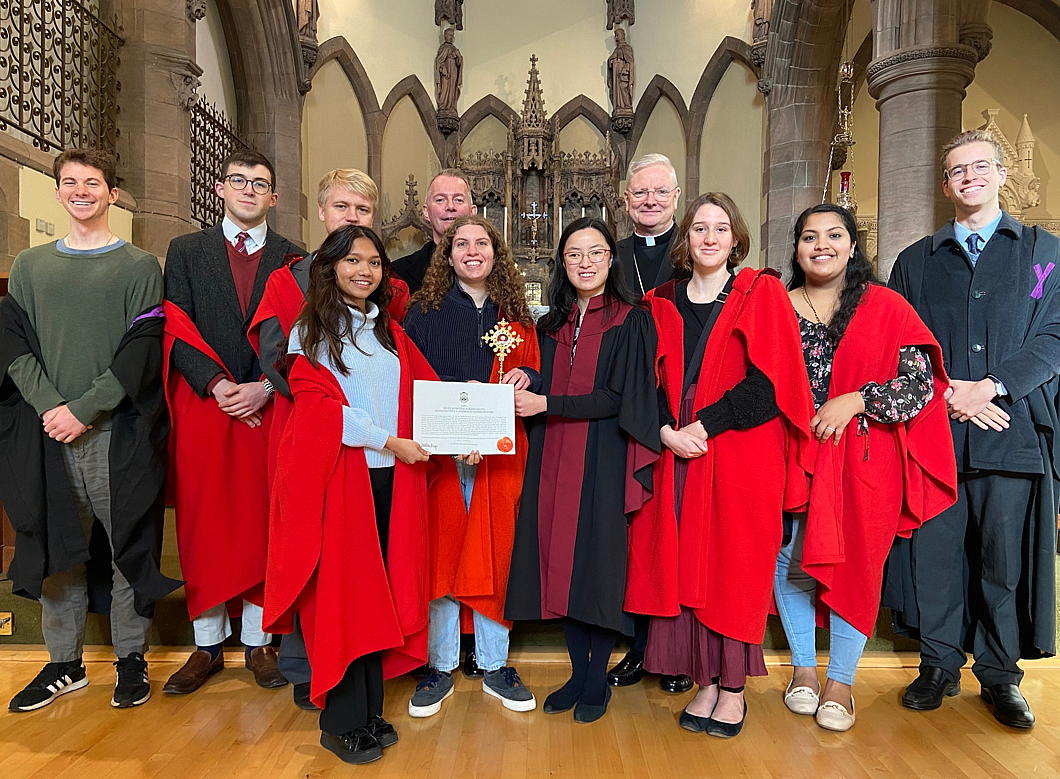
Students from St Andrews University have accompanied their Catholic chaplain to receive a relic of St Margaret of Scotland from the Archbishop of St Andrews & Edinburgh, Dr Leo Cushley.
The relic was put in the care of Canmore, the Catholic chaplaincy at St Andrews, whose chapel is dedicated to the Hungary-born English princess who became Scotland’s saintly queen.
When the relic in St Margaret’s Church in Dunfermline — the country’s royal centre in the twelfth and thirteenth centuries — were being removed from their reliquary the piece of bone fragmented.
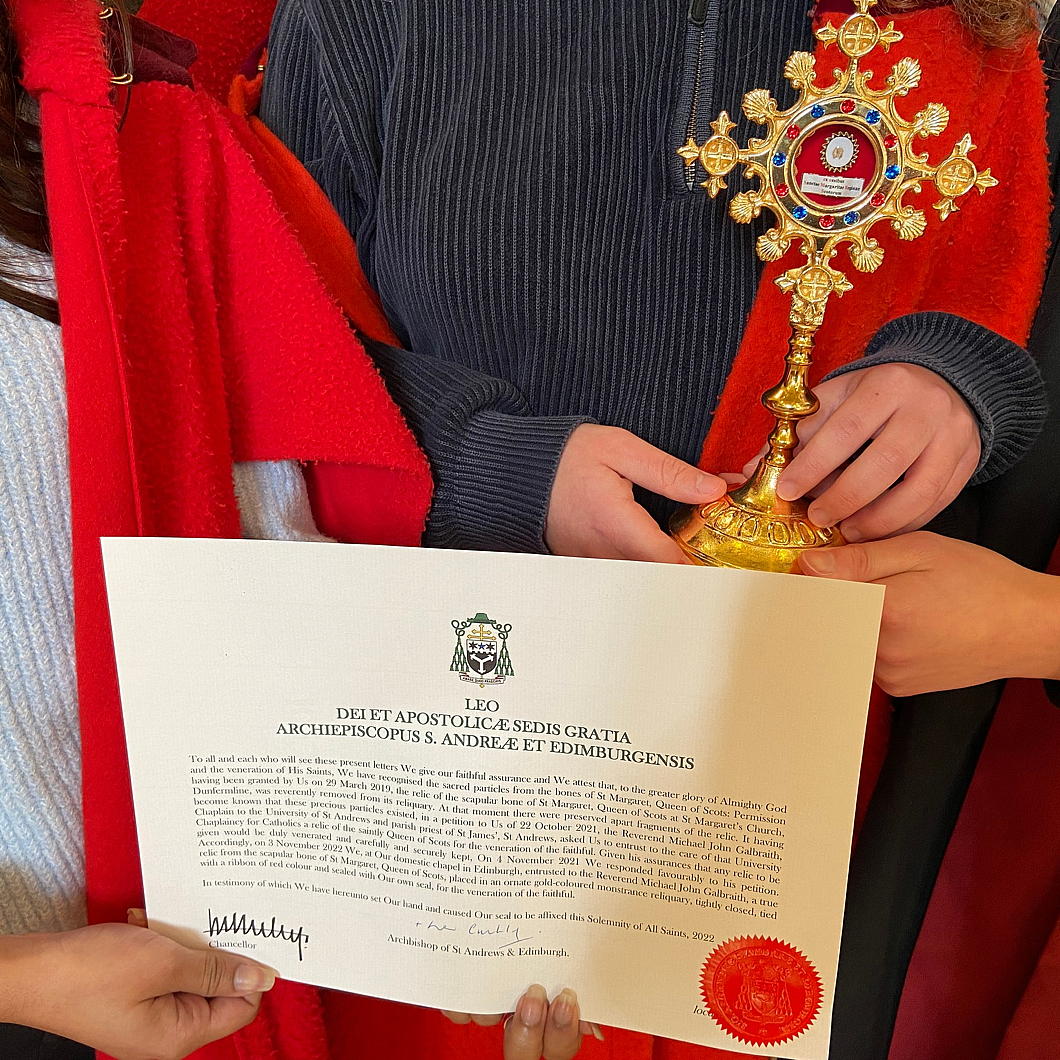
The Archdiocese decided to make this an opportunity for the relics of the royal saint to be distributed further.
This relic of St Margaret will remain in Canmore where it will be available for veneration by students and other visitors.
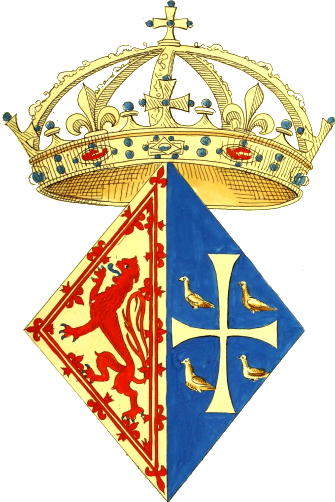
SAINT MARGARET
QUEEN OF SCOTLAND
pray for us
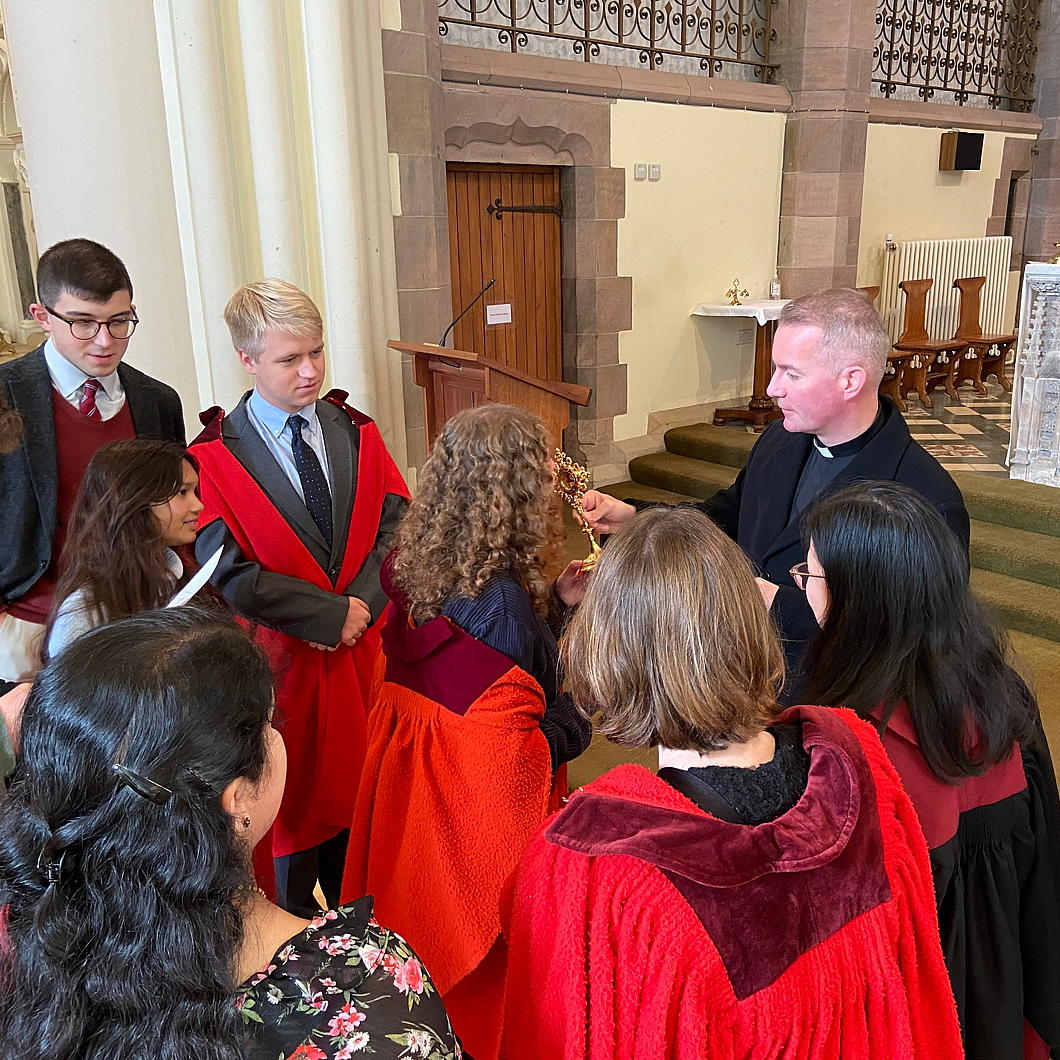
Caledonian Expedition
Sun, sand, champagne, Scotland: there’s not much more you could ever want, but to have an alignment of these four in the month of October is rare. It had been quite some time since the Cusackian feet had last graced the cobbles of the beloved ‘auld grey toun’ – the Royal Burgh of St Andrews – but a friend got in touch on a Monday morning with the provocative text “Scotland Friday?” I couldn’t resist. (more…)
Papal Mace for St Andrews
Archbishop Presents New Mace to Scotland’s Oldest University Amidst 600th Anniversary
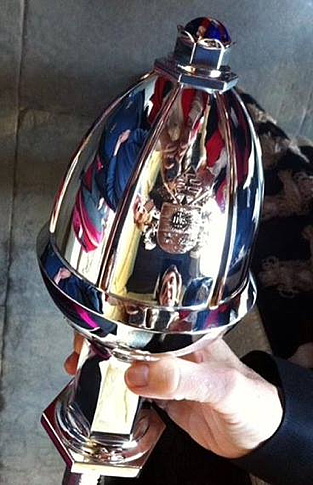
Above: The 600th Anniversary Mace.
Below: The University’s three medieval maces:
St Salvator’s College, 1461; Faculty of Canon Law, circa 1450; Faculty of Arts, 1416.
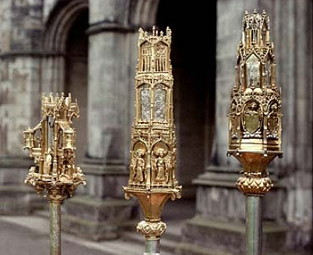
ST ANDREWS University already boasts the world’s finest collection of medieval maces, but a new ceremonial mace was added to the university’s hoard recently. In honour of the University’s six-hundredth anniversary, the Most Rev Leo Cushley, Archbishop of St Andrews & Edinburgh, has presented the institution with a new ceremonial mace on behalf of the Catholic Church.
“This completes a triple recognition of the University St Andrews,” said Dr John Haldane, the University’s professor of philosophy.
“During his visit to Scotland at the outset of this decade, Pope Benedict referred to the university beginning to mark the 600th anniversary of its foundation, then last year Pope Francis sent a message of congratulation, and now his office has granted permission for the inclusion of his coat of arms on the head of a mace commissioned to mark the completion of several centuries and the beginning of who knows how many more.”
The silver mace with gold rose details was crafted by Hamilton & Inches of Edinburgh, who also constructed the mace of the Faculty of Medicine at St Andrews over a half-century ago. Their master silversmith Jon Hunt designed the mace, in consultation with Prof Haldane.
The mace’s head is reminiscent of Brunelleschi’s dome of Florence Cathedral, recalling St Andrews’s links with the Continent which were foremost in the University’s first century and a half while it was a Catholic institution. Atop the head a saltire design is incorporated, referencing the apostle who gave his name to both the Royal Burgh and the University as well as the country who’s first university St Andrews is.
Heraldic shields display the arms of the University and of Pope Francis who invoked “upon all the staff and students of the University, past and present, the abundant blessings of Almighty God, as a pledge of heavenly peace and joy”. (more…)
The Situation at St Andrews
Or: A Lesson in Corroborating Your Sources
AS IF, WITH THE recent announcement that a certain St Andrean couple are getting engaged, there wasn’t enough for us to expend our idle chatter about, the University of St Andrews is thrust into the fore on an entirely separate matter. Damian Thompson, the provocative and informative Catholic Herald editor and indispensable Daily Telegraph blogger wrote a blog entry — Catholic students at St Andrews ‘can’t have the Latin Mass’ — relaying the claims of a student that he and a stable group of students have asked to have a monthly Mass in the Extraordinary Form, found a priest willing to say it, and have been denied. Fr. Z, the world’s most famous clerical blogger, soon picked up the story as well and made a few comments of his own.
The reality of the situation, it appears, is far removed from the one student’s claims. (more…)
Antipopes We Have Known
The University of St Andrews is commencing the celebrations of its 600th anniversary, as the institution was founded in stages between 1410, when teaching started, and 1413, when a bull was issued recognising it as a university by Pedro de Luna, an antipope who styled himself Benedict XIII. Yesterday I attended a fascinating lecture by Dr. John Rao — From the Triple Papacy to the Council of Constance — as part of the 2010–2011 lecture series organised by the Roman Forum.
Boy was Benedict a baddie! Even the council he called passed resolutions condemning him and the cardinals he appointed turned against him. He ended his days maintaining his schismatic claim, holed in island fortress of Peñiscola. The day before he died, he appointed four cardinals, who elected de Luna’s friend Gil Sanchez Muñoz y Carbón as Clement VIII. Or rather, three of the cardinals did while the fourth — Jean Carrier, the archdeacon of Rodez — wasn’t present, so he went and single-handedly elected his sacristan Bernard Garnier as pope, who took the name Benedict XIV.
Garnier was permanently in hiding, and his location was only ever known to Carrier. B-14 did manage to choose four cardinals of his own, and on the antipope’s death they elected Carrier pope, who was inconveniently captured and imprisoned by his rival antipope, Clement VIII. Oddly, having just succeeded the supposed Benedict XIV, Carrier chose to use the name and style Benedict XIV also. A novel by Jean Raspail (L’Anneau du pêcheur) depicts a line of anti-papal successors to the two Benedict XIVs.
As a lecturer, Dr. Rao is both informative and entertaining, and I’d encourage anyone interested to attend the remaining lectures in this year’s series. There’s always wine on offers and little things to nibble on, with a box for generous donations to be made towards the cost of the program. The next lecture is Martin V and the Troubled Return to Rome — this week is the 593rd anniversary of that pope’s election, as it happens.
Also, Dr. David Allen White, retired Professor of World Literature at the United States Naval Academy, returns to New York in December for the Syllabus of Errors Weekend, on the subject of Charles Dickens and the Evils of Modernity. I went to last year’s Syllabus of Errors weekend, and Professor White is entrancingly engaging, a veritable font of knowledge.
Preservation is Not Enough
A Proposal for Enhancement
IT IS COMMONLY said of St Andrews that it is a place of beauty. This is often a compliment to its natural setting, with open skies arcing over the reaches of the bay, and ancient rock and cliff yielding to the changing rhythms of the waves. At the same time visitors are generally struck by the pleasing combination of natural and built environments: the ruined grandeur of the Cathedral and Priory standing bare to the elements; crowstep-gabled cottages gathered in against the wind; the broad thoroughfares interlinked with narrow cobbled lanes; and the church towers etched against the sky. There is also the scholarly dignity of Deans Court, the quizzical posture of the Roundel, the charm of the courtyards to the south of South Street, the sad ruination of Blackfriars juxtaposed with the aspiring frontage of Madras College, and other evocative sights besides.
Here and there within the midst of all of this stands, physically, historically, and socially, the University. Its contributions to the architectural distinction of the old town are obvious enough. They are, principally, the harmonious South Street complex of St Mary’s College (1593-41) to the west, Parliament Hall (1612-43) to the north, and the Library extension (1889-1959) – now the Psychology wing – to the east; and the North Street set of the Collegiate Church of St Salvator, Gate Tower and tenement (1450-60), and beyond it the west block (1683-90) containing the Hebdomadar’s Room, and to the east and north the College buildings (1829-31 and 1845-6, respectively). There are other smaller and oft-reworked jewels associated within the University: St John’s House in South Street (15th, 17th, 18th, 19th, and 20th centuries), St Leonard’s Chapel (remodelled c. 1512), and the ‘Admirable Crichton’s House’ (16th century), but the principal architectural benefactions of the University to the town are the North and South Street college complexes. I have not mentioned the Younger Graduation Hall (1923-9) and the Student Union (1972) and prefer to leave it for readers to determine what might be said of these.
It could hardly have passed unnoticed that the list of contributions dates mostly from the late middle-ages to the nineteenth century, and this fact raises two questions: first, whether in the second half of the twentieth century the University was sufficiently attentive to its role as principal architectural patron; and second, how it might now hope to enhance the built environment of St Andrews. (more…)
St Andrews, William & Mary join forces
The oldest universities in Scotland and Virginia announce they will offer a series of joint degree programs
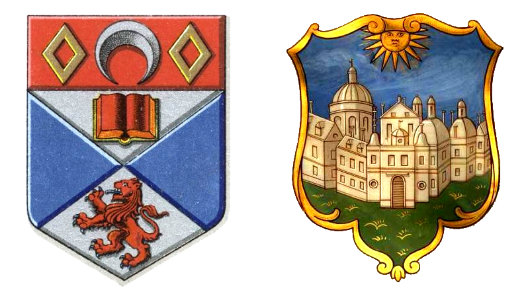
The University of St Andrews in Scotland and the College of William & Mary in Virginia are to begin offering joint degree programs starting in the autumn of 2011. Students admitted to the programs will receive a single Bachelor of Arts degree issued on behalf of both institutions — which will be the only B.A. offered by St Andrews, whose arts & humanities undergraduates typically graduate with an M.A.
The joint degrees will be available in four fields — history, international relations, English, and economics — with the aim of combining the depth traditional to the Scottish style of education with the breadth of William & Mary’s liberal curriculum. Students will spend the first year at their home university, followed by a second year abroad, with the remaining two years divided between the two. The program will start with about forty students divided between the two, with the hope to gradually double that size.
St Andrews is the oldest university in Scotland, and third-oldest in the English-speaking world. The College of William & Mary (now a university, despite its name) is the oldest in Virginia, the second-oldest in the United States, the third-oldest in North America, and the ninth-oldest in the English-speaking world. William & Mary, which is located in Virginia’s ancient capital of Williamsburg, has traditionally maintained links to Great Britain even after the Dominion of Virginia was recognised as independent in 1783. Queen Elizabeth II has visited the College twice, first in 1957 and more recently in 2007, and her former prime minister, Baroness Thatcher, served as Chancellor of the University.
The Would-Be King of New Zealand
Brigadier the Right Honourable Sir Bernard Fergusson,
Baron Ballantrae, KT, GCMG, GCVO, DSO, OBE
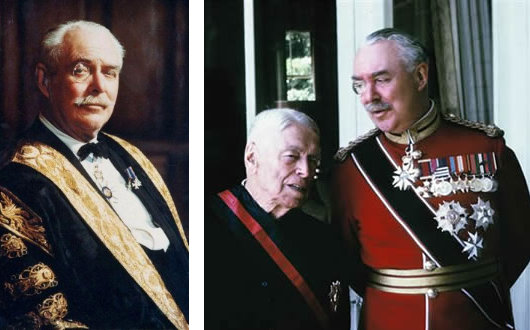
Left, Lord Ballantrae in his robes of office as Chancellor of the University of St Andrews; Right, as Governor-General of New Zealand with former Prime Minister Sir Walter Nash.
Over at Curated Secrets, Stephen Klimczuk takes a brief wander through Clubland, mentioning the illustrious Bernard Fergusson, who was known for “the skill with which he could toss his monocle in the air and catch it in his eye”. Stephen’s co-author on Secret Places, Hidden Sanctuaries, the Much Hon. Laird of Craiggenmaddie, chimes in on the commentbox, bringing to light that “when he was serving under Orde Wingate with the Chindits in Burma, among the supplies dropped by the RAF to those doughty warriors was a supply of monocles for Fergusson, since the damage/loss rate was so high in the jungle.”
Fergusson has always fascinated me, not only because he was the Chancellor of my university, but also because he has the best claim to the throne of New Zealand should the Land of the Long White Cloud ever decide to dispense with the House of Windsor. Lord Ballantrae (as Fergusson was ennobled) served as Governor-General of New Zealand, his own father served as Governor-General of New Zealand, and both his grandfathers served as Governor of New Zealand before the antipodean kingdom became a dominion. Rather appropriately, his son and heir is currently serving as Her Majesty’s High Commissioner to New Zealand, which is now the highest office of the British government in those islands.
Stephen mentions other fun stories of Clubland, such as the waggish response of the dinner guest who was kept waiting for Hermann Goering at one club before the war: “‘I have been shooting,’ said Goering. ‘Animals, I hope?’ was the quite reasonable question in response.”
The Mitre
I’ve uploaded the last eleven issues of The Mitre — “the quality student newspaper at the University of St Andrews” — before its demise after the Midsummer’s Day issue of 2005. The old Mitre website can be found here.
David Kerr for Glasgow North East
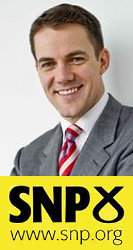 While the baggage-handler and much-celebrated hero of the Glasgow Airport attacks, Mr. John Smeaton QGM (“This is Glasgow; we’ll set aboot ye. … You’re no’ hitting the Polis mate, there’s nae chance.”) has announced he is going to contest the Glasgow North East by-election for some fringe electoral outfit, this blog is happy to report that there is already a perfectly laudable candidate who is seeking the privilege of serving the constituents of that district at Westminster.
While the baggage-handler and much-celebrated hero of the Glasgow Airport attacks, Mr. John Smeaton QGM (“This is Glasgow; we’ll set aboot ye. … You’re no’ hitting the Polis mate, there’s nae chance.”) has announced he is going to contest the Glasgow North East by-election for some fringe electoral outfit, this blog is happy to report that there is already a perfectly laudable candidate who is seeking the privilege of serving the constituents of that district at Westminster.
Mr. David Kerr, a Catholic graduate of the University of St Andrews and until recently a senior editor of BBC Scotland’s “Reporting Scotland” programme, is the Scottish Nationalist candidate for Glasgow North East. The Labourite newspapers have already set David Kerr as the target of their sleaze machine, first for a derogatory comment about Glasgow Caledonian University “not having a reputation to tarnish” made in a jocular spirit of inter-academic rivalry, then over a television investigation into the availability of weaponry in which Mr. Kerr was pictured with… well, weapons! (Oh, the horror! Vote Labour!)
Mr. Kerr is believed to be a favourite of SNP leader Alex Salmond, the First Minister of Scotland. The SNP are currently the only major party in mainland Britain who are actively pursuing the Catholic vote. While SNP members tend to be vaguely left-wing and pro-independence (as is the official party policy), SNP voters are often more traditional or conservative and in favour of preserving some form of union. (The Conservative Party, meanwhile, is frequently perceived as a party for liberal English toffs; a perception reinforced by David Cameron’s leadership). The Nationalists are doubtless trying to repeat their victory over Labour in last year’s Glasgow East by-election, in which ethical issues are believed to have played a significant role in Labour’s defeat.
The bookmakers Ladbrokes are currently giving David odds of 5/4 in winning the seat, against 4/6 for Labour’s Willie Bain.
Over There
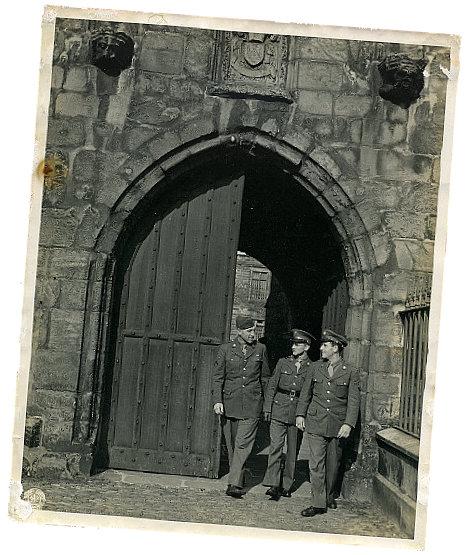
American GIs in St Andrews, 1943.
Buckham’s Britain

 The Daily Telegraph shows us a number of photos taken by Alfred Buckham, an aerial photographer of the 1920s. Buckham was introduced to the art during his time with the aerial reconnaissance branch of the Royal Naval Air Service in the First World War.
The Daily Telegraph shows us a number of photos taken by Alfred Buckham, an aerial photographer of the 1920s. Buckham was introduced to the art during his time with the aerial reconnaissance branch of the Royal Naval Air Service in the First World War.
The images themselves are composite photographs combining actual aerial views of cities and landmarks throughout Great Britain with views of the aircraft of the day flying through the skies.
As the Telegraph notes, Buckham “eschewed safety devices, saying: ‘I have used a safety belt only once, and then it was thrust upon me. I always stand up to make an exposure and, taking the precaution to tie my right leg to the seat, I am free to move about rapidly'”.
A new book on Buckham, A Vision of Flight: The Aerial Photography of Alfred G. Buckham, has just been written by Celia Ferguson, and is published by The History Press.
Professor Haldane in the Catholic Herald

The Catholic Herald talks to Professor Haldane about the Church’s failure to halt the revolting HFE bill that recently passed (the one authorizing animal-human hybrids and the creation of human “saviour siblings” in labs for organ harvesting) and they have a nice picture of the Good Professor in his sitting room at St Andrews. Prof. & Mrs. Haldane were always very welcoming to students and had a whole bunch of us over a number of times. As I wrote before:
He has a library to be envied as well.
In my very first year at St Andrews, I had the privilege of shaking the hand of none other than Mr. James Macmillan (Greatest Living Scotsman!) at Professor Haldane’s. Certainly one to remember.
Cry God for Britain, Harry, and St. Aidan?
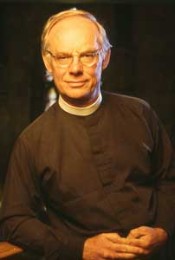
“St Aidan unites three of the countries by having lived there,” Dr. Bradley says, “and is, I believe, a better symbol for Britishness” [than the George, Andrew, and Patrick, the patrons of England, Scotland, and Ireland respectively].
“It’s like Billy Bragg says in his song ‘Take Down the Union Jack’ about Britain; ‘It’s not a proper country, it doesn’t have a patron saint’. Aidan was the sort of hybrid Briton that sums up the overlapping spiritual identities of Britain.
“He also makes a good patron saint of Britain because of his character. He was particularly humble and believed in talking directly to people. When he was given a horse by King Oswald of Northumbria, he immediately gave it away because he was worried that he would not be able to communicate properly.
“He was also not shy of reprimanding the mighty and powerful about their failings. He saw it as part of his job to remind secular rulers not to get above themselves. At a time when we are thinking about what makes Britishness, he had a sense of openness and diversity for his time that I think makes him a good candidate as the patron saint of Britain.”
Find out more in this article:
“Home-grown holy man” (The Independent, 23 April 2008)
On a somewhat similar note, here’s Aelianus (one of our favourite bloggers) writing on British Identity last September.
Dr. Strangelove & Dr. Timmerman
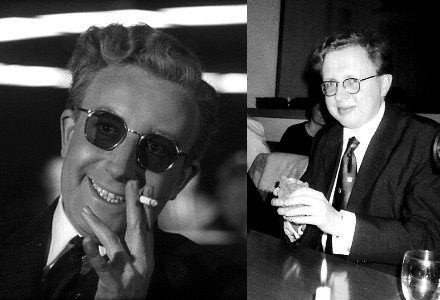
I’ve always had suspicions about my friend Dr. Jens Timmerman, a Göttingen/Balliol man and the Frankfurter Allgemeine Zeitung‘s only subscriber in the Royal Burgh of St Andrews. He clearly has some Strangelovian blood in his veins.
One of the best things about Jens (apart from being a man of erudition and taste) is his refusal to give in to the low standard of propriety maintained by students; especially the practice of arriving for his lecture, picking up the handout, and leaving immediately. One day he made a fake handout and waited for the lazybones to leave before distributing the real handout to the remnant. It included, under ‘Further Reading’, a guide to manners and etiquette. Also, I am informed that whenever a mobile phone goes off during one of his lectures he pronounces “Please turn off your walkie-talkies!”
Last Barbecue of the Year
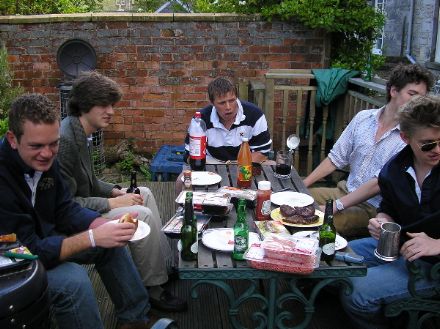
Today marked the final barbecue I am ever likely to attend at No. 12 Queens Gardens. The current inhabitants are moving out and new, strange people will move in next year, who are foreign to me.
No. 12 was quite recently home to Barbecue Challenge 2005 (BBQC05). The challenge was that during Reading Week (the week between the end of class and the start of exams) for all the partcipants to have all meals – breakfast, lunch, and dinner – on the barbecue. It lasted from Monday until Friday, and I am happy to say that of the twelve who started out, I am one of three who managed to last all the way through. The others were Chris C. and George Irwin.
Anyhow, I have enjoyed plentiful good times at No. 12, more than I deserve. Home to Chris, Dave, Alex, Jenny, and ZaZa, it was always a comforting place when things were irritating me; a veritable home away from home. And because they have satellite television, there was always at least one program about Irwin Rommel on for us to watch whilst slowly sipping a cup of Earl Grey. From getting sunburnt in the garden while studying this term, to the time Cockburn the Younger was ill atop the herb garden, No. 12 has been a font of good times and fond memories, and long may it be so to its future residents. No. 12, I shall miss thee.
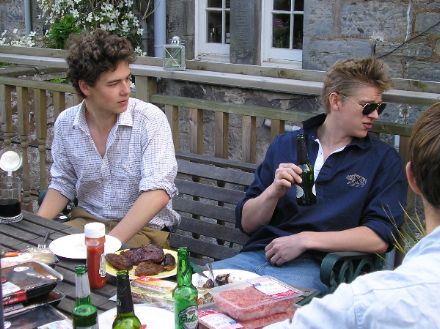
Pining for Andreanopolis
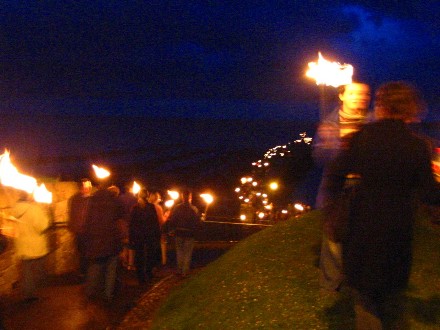
Photo: Peter Tweed
Just over a fortnight to go, but a number of things I miss about St Andrews:
The people (too many to mention), wearing academic gowns, torchlit processions, dinner parties, St. Salvator’s Chapel, three-piece suits at Chapel, lady preachers making fools of themselves at Chapel, the after-Chapel bit of sherry, tweed, the Kensington Club, tweed, the ruins of the Cathedral, tweed, the Pier, the East Sands, the West Sands, Castle Sands, the Castle, the Castle Tavern, the Central, Broon’s, Ma Bell’s, not so much the Westport but their beer garden instead, eating at the Golf Hotel, reading the magazines in the common room of Canmore, reading everything else in the library of Canmore, big dinner thursdays, avoiding the Students Union at all costs, Queens Gardens, the Quarto, the Bouquiniste, chips, the late movie on Wednesday nights, anything and everything Richard Demarco is involved in, plotting reaction, writing the Mitre, reading the Mitre, reactions to the Mitre, St. Leonard’s Chapel, candlelit compline, the Scores, Boots’ meal deal, the evangelists in the streets, Parliament Hall, St. Mary’s Quad, St. Katharine’s Lodge, St. John’s House, the King James Library, the Bunk Room in St. Mary’s, Professor Haldane’s house, the hallway chat after the daily Rosary, the Parish garden, Fr. Halloran’s black vestments and the fact that he still uses them, the Latin Mass in Edinburgh and everything that goes with it, the Telegraph, the Spectator, making fun of people, being made fun of, evensong at Holy Trinity, the Renaissance Group, St. Salvator’s Hall, Hamilton Hall, University Hall, Lower College Hall, the Old Union Diner, Butts Wynd, St. Salvator’s Quad, North Street, Market Street, South Street, the Pends, the Cemetary, the cloister, the chapter house, driving up and down the Fife coast, awkward people, the Whiskey-tasting Society (oh boy!), unapologetic support for the monarchy, international diplomacy, an appreciation for Chesterton, representing New York abroad, beautiful and charming South African tutors, Dean’s Court, champagne, the Royal & Ancient, innocent decadence, Kinburn Park and the lawn bowling club, Bishop Kennedy’s tomb, the Buchanan, falling asleep in lectures, doing the crossword in lectures, inscribing the Sacred Heart of Jesus, monarchist slogans, or anachronistic pro-Rhodesian graffiti onto lecture hall desktops, tea after Mass, Country Life, the Kate Kennedy Procession, buying the papers at J+G Innes, formal events, wearing the old school tie, the Annual Boules Match in St. Mary’s College, the Younger Hall, plotting to start a croquet club, people willing to sacrifice their lives for their country, my complete inability to write an essay without Jameson’s, paninis from Cherries, Luvian’s wine shop, all the alleyways, the Byre Theatre, the bar at the Byre, Pimm’s on the lawn, Christianity being taken seriously, incessantly amusing people, life in St Andrews. Life in St Andrews!
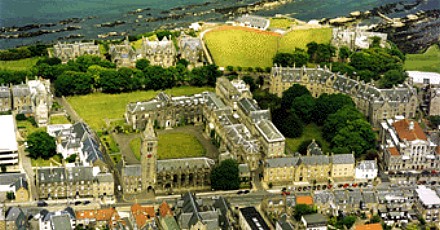
Ah, St Andrews!
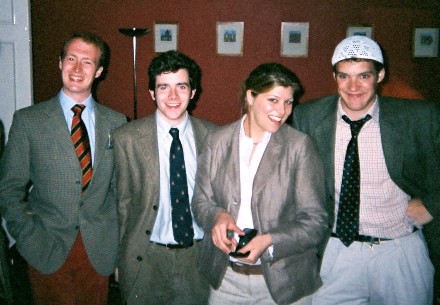
Was feeling a bit nostalgic for St Andrews. Won’t be heading back until Sept. 20, so I figured I’d put up a photo of fellow St Andreans and me with jovial countenances.

And the mantle from my room the past year. For a closer up look at the random items including architectural books, John le Carré novels, the program from the Knights of Malta ball, a bottle of cheap red, the Penguin editions of Gerald of Wales, and Alfred the Great, and R.G. Cant’s history of St. Salvator’s College, click here.
Search
Instagram: @andcusack
Click here for my Instagram photos.Most Recent Posts
- Telephone Kiosk No. 2 May 15, 2024
- The last of its vintage May 15, 2024
- Letters Patent May 8, 2024
- Bicycle Rack April 29, 2024
- Burns Tower April 19, 2024
Most Recent Comments
Book Wishlist
Monthly Archives
Categories


